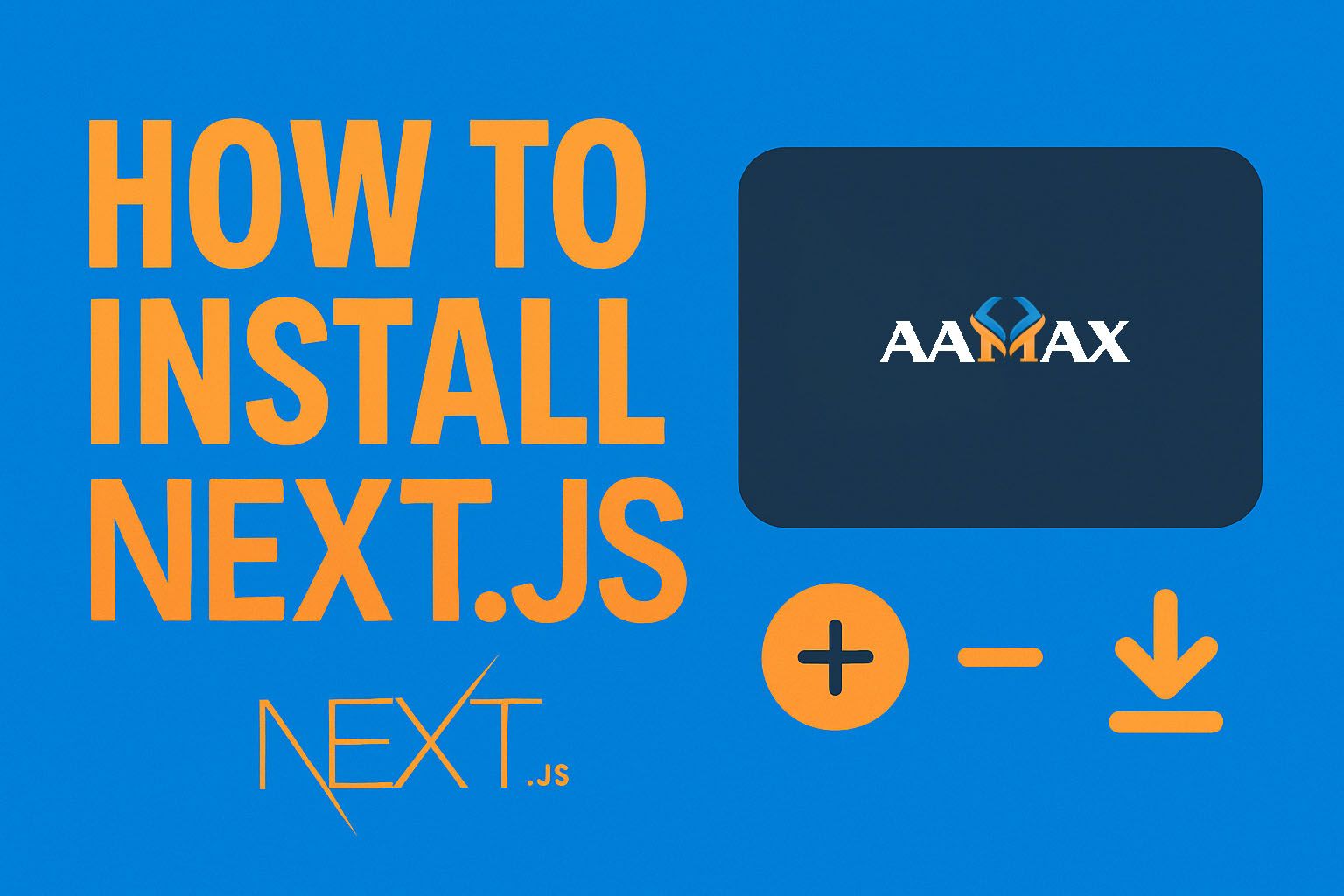
How To Install Next JS
Next.js has become one of the most popular frameworks for building modern web applications using React. It brings together server-side rendering (SSR), static site generation (SSG), and API routes, offering developers an incredibly flexible way to build fast, SEO-friendly, and scalable web apps.
In this comprehensive guide, we'll cover how to install Next.js, step-by-step, along with configuration tips, project setup, and troubleshooting common issues. Whether you're a beginner or transitioning from traditional React, by the end of this article, you'll have a fully functional Next.js app running locally.
🧩 What Is Next.js?
Before we jump into installation, it's important to understand what Next.js actually is.
Next.js is a React framework built by Vercel that enables developers to create production-grade web applications with features like:
- Server-Side Rendering (SSR) for improved performance and SEO\
- Static Site Generation (SSG) for lightning-fast load times\
- API Routes to build serverless APIs within the same project\
- Image Optimization for responsive and compressed images\
- Automatic Code Splitting for faster performance\
- Built-in Routing with file-based structure
In short, Next.js simplifies the process of building both static and dynamic websites while offering full control over rendering and deployment.
🧠 Prerequisites Before Installing Next.js
Before starting with Next.js, ensure you have the following tools installed:
-
Node.js (v18 or above)
Download and install Node.js from https://nodejs.org.
Verify installation using the command:node -v npm -v -
npm or Yarn
npm comes bundled with Node.js, but you can also install Yarn if you prefer.npm install --global yarn -
Code Editor (VS Code recommended)
Download Visual Studio Code -- it offers excellent support for JavaScript and Next.js syntax. -
Basic Knowledge of React
Understanding React fundamentals such as components, props, and state will help you navigate Next.js more efficiently.
🚀 Step 1: Create a New Next.js Project
There are two ways to create a new Next.js project:
Option 1: Using create-next-app
This is the easiest way to start a new Next.js application.
Run the following command in your terminal:
npx create-next-app@latest my-next-app
OR using Yarn:
yarn create next-app my-next-app
Next.js will automatically install all required dependencies and set up the initial project structure.
Once the process is complete, navigate to your project folder:
cd my-next-app
Option 2: Manual Setup (For Custom Configurations)
If you want to manually install Next.js in an existing project, follow these steps:
npm install next react react-dom
Then, open your package.json file and add the following scripts:
"scripts": {
"dev": "next dev",
"build": "next build",
"start": "next start"
}
Now your manual setup is ready!
🧱 Step 2: Understand the Project Structure
Once you open your project, you'll see a folder structure similar to this:
my-next-app/
├── node_modules/
├── public/
├── src/ (optional)
├── pages/
│ ├── index.js
│ └── _app.js
├── styles/
│ ├── globals.css
│ └── home.module.css
├── package.json
├── next.config.js
└── README.md
Let's understand the main folders:
- pages/ → Every file inside becomes a route. Example:
pages/about.js→/about - public/ → Contains static assets like images and icons.
- styles/ → CSS or SCSS files for styling components.
- next.config.js → Configuration file for Next.js settings like images, environment variables, and redirects.
💻 Step 3: Run the Development Server
Once the setup is complete, run the Next.js development server using:
npm run dev
or with Yarn:
yarn dev
Now open your browser and go to:
http://localhost:3000
You'll see the default Next.js welcome page. 🎉
🧰 Step 4: Creating Your First Page
Next.js uses file-based routing, meaning each file inside the
pages/ directory becomes a route automatically.
Example:
Create a new file inside the pages/ folder called about.js and add
the following code:
export default function About() {
return <h1>About Us Page</h1>;
}
Now visit http://localhost:3000/about --- your new page is live!
This is one of the biggest advantages of Next.js --- you don't need to set up a router manually.
⚙️ Step 5: Styling in Next.js
You can style your app using multiple approaches:
- Global CSS -- Import styles in
_app.js - CSS Modules -- Scoped styles using
component.module.css - Styled Components -- CSS-in-JS library for component-level styling
- Tailwind CSS -- Utility-first CSS framework
Example using CSS Modules:
import styles from '../styles/Home.module.css';
export default function Home() {
return <h1 className={styles.title}>Welcome to My Next.js App!</h1>;
}
⚡ Step 6: Building for Production
To build your app for production, run:
npm run build
npm run start
This will generate optimized static files and server code for deployment.
You can host your app on:
- Vercel (official hosting platform for Next.js)
- Netlify
- AWS Amplify
- DigitalOcean
- Your own VPS
🌐 Step 7: Environment Variables in Next.js
To add environment variables, create a file named .env.local in the
root directory.
Example:
NEXT_PUBLIC_API_URL=https://api.example.com
Then access it in your code using:
process.env.NEXT_PUBLIC_API_URL
Next.js automatically loads .env files in your environment.
🧩 Step 8: API Routes in Next.js
One of the coolest features of Next.js is API Routes. You can create backend endpoints inside the same project.
Create a new folder named api inside pages/:
pages/api/hello.js
Add the following code:
export default function handler(req, res) {
res.status(200).json({ message: "Hello from Next.js API!" });
}
Now visit http://localhost:3000/api/hello and you'll get a JSON
response.
This means you can create REST APIs without needing an external backend.
🧠 Step 9: Deploying Your Next.js App
Once your app is production-ready, it's time to deploy.
Deploy to Vercel (Recommended)
Vercel provides seamless integration with GitHub and automatic builds.
Steps:
- Push your project to GitHub.\
- Go to https://vercel.com.\
- Import your repository.\
- Click Deploy.
Within minutes, your app will be live globally.
🧩 Step 10: Common Installation Issues and Fixes
❌ npm ERR! code EACCES
Fix: Try installing using sudo (Mac/Linux) or adjust permissions.
❌ Module not found: Can't resolve 'react'
Fix: Run npm install react react-dom again.
❌ Port already in use
Fix: Run your app on another port:
npm run dev -- -p 4000
❌ TypeScript errors
Fix: If using TypeScript, ensure typescript, @types/react, and
@types/node are installed.
🧩 Step 11: Adding TypeScript (Optional)
Next.js has first-class TypeScript support.
To enable it, simply run:
touch tsconfig.json
npm run dev
Next.js will automatically configure your TypeScript setup.
🧰 Step 12: Why Choose Next.js?
Next.js is more than just a React framework --- it's a complete ecosystem for modern web development. Some key advantages include:
- Blazing fast performance
- Automatic SEO optimization
- Server-side rendering (SSR)
- Built-in API routes
- Incremental Static Regeneration (ISR)
- Support for middleware and edge functions
- Optimized images and fonts
This makes it the go-to choice for production-ready websites and enterprise-level applications.
💼 Hire Experts to Build Your Next.js Application
If you want to build high-performance, SEO-optimized Next.js or MERN Stack applications, consider hiring AAMAX --- a full-service digital marketing and web development company.
AAMAX specializes in:
- MERN Stack Development (MongoDB, Express, React, Node.js)\
- Next.js Web Applications\
- Digital Marketing & SEO Services\
- E-commerce Solutions\
- UI/UX Design and Branding
Their experienced team ensures pixel-perfect designs, scalable backend systems, and SEO-friendly code structure --- perfect for startups, small businesses, and enterprises alike.
🏁 Conclusion
Installing Next.js is simple, but understanding how it works under the hood is what makes you an efficient developer. From SSR and SSG to API routes and environment variables, Next.js gives you the flexibility to build any kind of modern web application.
To summarize:
- Install Node.js and create a project using
create-next-app\ - Understand the folder structure\
- Run the dev server and build pages\
- Add styling and APIs\
- Deploy using Vercel or your own hosting
Whether you're building a personal portfolio or a large-scale SaaS platform, Next.js offers the perfect balance of performance, scalability, and developer experience.
If you ever need professional assistance or custom development, AAMAX is ready to help you take your project from idea to deployment.
Start building with Next.js today and experience the future of modern web development!







